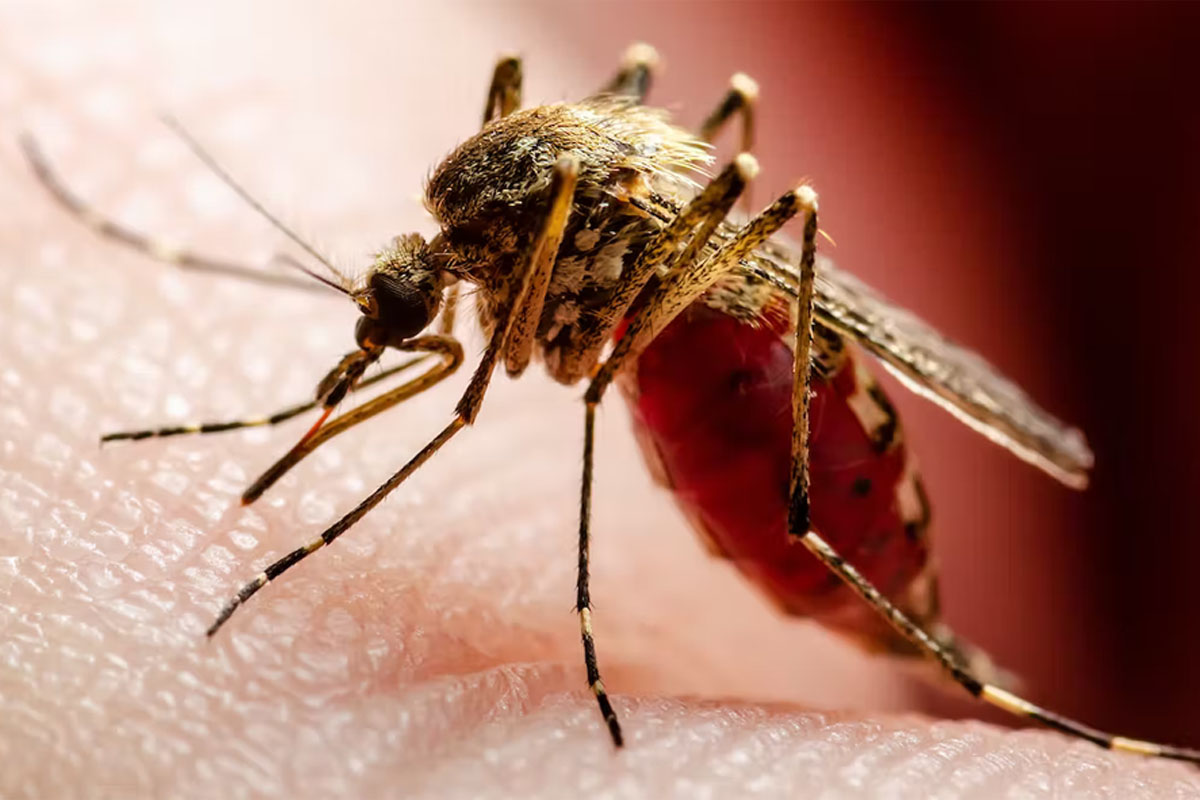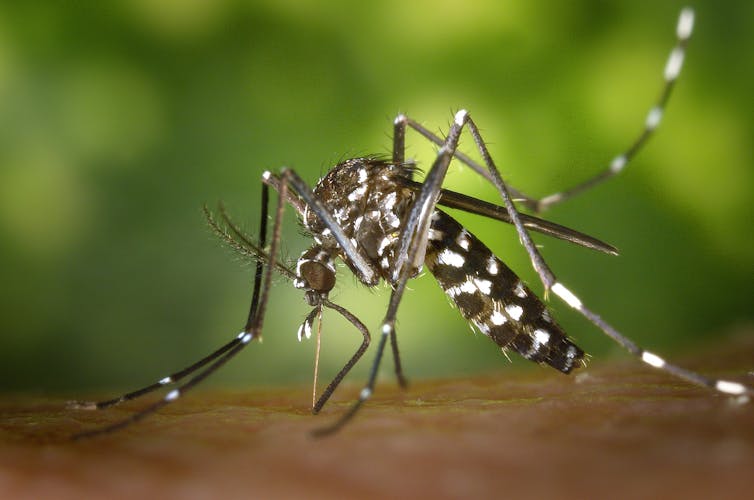How mosquitoes bite us (and the consequences)
Ticks, mosquitoes, wasps, ants... In summer, the risk of encountering a little beast that stings, bites or lacerates increases sharply. Our series "Un été qui pique" ("A summer that stings") takes a look at the most frequent stings, the worst, and how to avoid them. For this first article, Yannick Simonin (University of Montpellier) and Sébastien Nisole (Inserm) invite us to meet a serious contender for the title of king of bites: the mosquito!
Yannick Simonin, University of Montpellier and Sébastien Nisole, Inserm

They're all around us, often invisible, and by the time we detect their presence it's usually too late... A little pain followed by itching, redness and a pimple? The mosquito has claimed a new victim and added you to its long list of favorite targets!
An unwelcome surprise guest at our summer aperitifs, the mosquito doesn't just bite humans - far from it. Depending on their preferences, their first victims are either birds or terrestrial mammals, especially pets such as cats and dogs. And some species even attack "cold-blooded" animals like frogs and snakes!
But how does this tiny insect manage to sting even the toughest skin? And what consequences can its misdeeds have on the organisms of its victims?
Blood, the guarantee of well-born offspring
First of all, it should be remembered that only female mosquitoes bite, the males preferring flower nectar or other sources of sugar (such as honeydew, a thick, viscous liquid excreted by certain insects that parasitize plants, such as aphids, whiteflies, mealybugs...) to our blood. And with good reason: they don't have a stinging apparatus...
In full flight, it's not easy to distinguish the harmless males from the females. Careful observation, however, will reveal feathery antennae on the heads of males, which are absent from the heads of females. But in any case, if a mosquito bites you, it's bound to be a female!
[Nearly 70,000 readers trust The Conversation newsletter to better understand the world's major issues. Subscribe today]
Why are females so keen on blood meals? Quite simply because the blood they collect is a rich source of protein, used to complete the maturation of their eggs after fertilization by the male. So blood is not used to feed mosquitoes, but to enable their offspring to be born. No bite, no new mosquito!
The mosquito is well equipped
To bite us, the female mosquito has a formidable arsenal. It's made up of a proboscis, or proboscis-like proboscis, which in turn is made up of "vulniferous" (capable of injuring) mouthparts, the stylets. These mouthparts are enveloped by the flexible labium, which folds up when the beetle is bitten. Unlike a stinger, the mosquito's proboscis is flexible, making it easier to reach the bloodstream.
When stung, the stylets pierce the epidermis and "grope" their way through, looking for a blood vessel. Buccal appendages, called maxillae, hold the proboscis in place. At the same time, via another appendage, the mosquito injects its saliva. Saliva contains substances that prevent blood vessels from contracting, and thins the blood to prevent coagulation and platelet aggregation, the initial stage in wound healing. The stylets thus delimit two canals: the alimentary canal, through which blood is drawn, and the salivary canal, through which saliva is injected.
Depending on the species, mosquitoes draw between 0.001 and 0.01 milliliters of blood. A tiny quantity of blood for us, but enormous for it: it can be equivalent to the insect's own blood volume. And it's all swallowed in less than 2 minutes!
While the victim doesn't have to worry about the amount of blood taken, the sting leads to other problems, more or less serious...
A brief history of skin
To understand the consequences of a mosquito bite, let's take a look at the body's largest organ: the skin. In direct contact with the outside world, it performs a number of functions essential to our organism, including protection from the external environment and perception.
The skin is organized into two main layers: the epidermis, the superficial part of the skin, and the dermis, the thicker support tissue beneath the epidermis.
The epidermis is mainly composed of keratinocytes, so named because they produce keratin, a hydrophobic protein that forms tough filaments and gives the epidermis its suppleness, impermeability and resistance. Once on the surface of the epidermis, these cells form a layer of dead cells, the stratum corneum, which is eventually eliminated by desquamation.
The dermis is made up of scattered cells within an extracellular material of fibers made of collagen and other proteins. The main cells of the dermis are fibroblasts, which produce these fibers, but the dermis also contains nerve endings, blood vessels, and the sebaceous and sweat glands, which produce sebum and sweat respectively.
As the interface between the body and the external environment, the skin is exposed to a wide range of stresses, particularly mechanical and thermal. It also has a front-row seat to micro-organism attacks, since it is an unavoidable gateway for the many pathogens that attempt to penetrate the body.
As such, it's a strategic outpost of the immune system, home to numerous sentinel cells that guard against viral, bacterial and fungal attacks.
Mosquito saliva, the source of our discomfort
A mosquito bite is just one of the many assaults on the skin. When a mosquito bites, its proboscis penetrates the epidermis and then the dermis in search of a blood capillary.
In addition to the physical aggression of this insertion, it is above all the saliva injected during the operation that triggers a reaction in our skin. It contains a complex mixture of proteins, which is recognized by the skin's immune system as a foreign agent.
The reaction is almost immediate. Immune cells known as mast cells are the first to react. They secrete histamine, an inflammatory mediator that increases the diameter and permeability of blood vessels, causing edema: the famous mosquito pimple. Histamine also stimulates nerve fibers, causing itching and the irrepressible urge to scratch.
Many components of mosquito saliva can be allergenic. In the case of the tiger mosquito(Aedes albopictus), some fifteen salivary components have been identified that can provoke an allergic reaction! What's more, the composition of saliva can vary from one species to another (as can the number of allergens). Last but not least, reactions vary from one person to another, as individual sensitivity to the sting is not the same for everyone.

James Gathany, CDC / Wikimedia Commons
Histamine is not only involved in mosquito bites. This molecule also plays an important role in allergic reactions, notably to pollen, latex or certain foods. It is thus responsible for allergic symptoms such as runny nose, tears, reddening of the skin, itching... Which can, in very rare cases, have certain consequences after a mosquito bite.
Rare complications
Mosquito bites generally fade within a few days, so they're not really dangerous in themselves. Although the itching remains localized on the skin, it can sometimes be severe for the most sensitive among us.
Complications are rare, but some people are at greater risk of strong allergic reactions or even anaphylactic shock, especially children who have not yet developed a natural tolerance to mosquito bites.
In very rare cases, bites cause Skeeter's syndrome, a systemic inflammatory reaction associated with fever, sometimes accompanied by vomiting and respiratory problems. This syndrome results from a hypersensitivity reaction due to the production of antibodies (immunoglobulins E, or IgE, and G, or IgG) directed against certain components of mosquito saliva.
Reduce itching
There are many marketed products and "homemade" recipes to alleviate the sting and associated itching. These include the use of a cloth soaked in hot water on the sting or, conversely, an ice cube, as well as alcohol-based compresses and certain essential oils.
Antihistamine ointments or oral antihistamines are often highly effective. Corticosteroid-based ointments are also used. They help reduce the itching and swelling caused by the inflammatory reaction.
But the main problem with the sting is not the rare complications or the inconvenience of itching, even if the resulting discomfort is undeniable.
In some cases, mosquitoes don't come alone. Depending on the region of the globe and the species in question, they can carry bulky partners, viruses or parasites that are more or less dangerous to humans. And when they bite, these stowaways can find their way into our bodies.
Beyond pimples, the risk of infection
The problem of arthropod-borne viruses (ARthropod-BOrne VIRUSes), i.e. transmitted by insects such as mosquitoes, is not new. But while it has long been a problem in tropical and subtropical regions, it has now moved to our latitudes, along with the mosquitoes that carry these diseases.
Indeed, the geographical distribution of certain mosquito species, notably the tiger mosquito(Aedes albopictus), has increased considerably in recent decades. Once confined to Southeast Asia, this invasive species has spread across the globe: today, only Antarctica is still free of this mosquito and the viruses it transmits, such as Dengue fever, the Zika virus and the Chikungunya virus. As a result, indigenous cases of mosquito-borne viral diseases are on the rise in new latitudes, including the French Mediterranean.
But these viruses can be dangerous. After replicating on the skin following a bite (mainly after infection of the skin's immune cells), they can enter the bloodstream, from where they can reach numerous organs. Liver, spleen, kidneys... Many organs are affected. But the most serious damage occurs when some of these viruses reach the brain.
As the immune system is naturally relatively weak, they can multiply at will, if they manage to cross the barriers protecting the brain, and induce various serious pathologies: encephalitis (inflammation of the brain), meningitis (inflammation of the meninges) or meningoencephalitis (inflammation of the meninges and brain).
Protecting yourself from bites
The best way to avoid the inconvenience and potential risks associated with bites is to make sure the mosquito doesn't manage to add us to its long list of victims.
Moreover, avoiding the bite not only protects you, but also slows down the reproductive cycle of the female mosquito, which will have to search for a new victim in order to lay its eggs. Since a female mosquito can lay several hundred eggs each time, and the females of some species can lay several times during their lives (usually around 5), the effort is not insignificant!
Every precaution is therefore advisable: loose-fitting, covering clothing, mosquito nets, repellents... We must also take care to eliminate all stagnant water in our environment, which can be conducive to the spread of mosquitoes, by emptying flowerpot bowls, watering cans, covering rainwater receptacles, etc.
On the other hand, parapharmaceutical gadgets such as "anti-mosquito bracelets" should be avoided at all costs, as these accessories are at best ineffective, and at worst, harmful. Indeed, in April 2020, the Anses (Agence nationale de sécurité sanitaire de l'alimentation, de l'environnement et du travail) warned of the risks of these devices, which can lead to irritation or burns in particular.
So it's best to opt for good old-fashioned, tried-and-tested natural methods, such as mosquito repellent candles and spirals, which give off the scent of citronella, geranium or lavender... Mosquitoes are very sensitive to odors.
The notion of "mosquito skin" is justified. In fact, the odors given off by our skin and the bacteria that colonize it (odors amplified by perspiration in particular), make our epidermis more or less attractive to mosquitoes. So we're not all equal when it comes to the risk of being bitten. Fortunately, the means of preventing and combating their spread work for everyone!![]()
Yannick Simonin, Virologist, lecturer in surveillance and study of emerging diseases, University of Montpellier and Sébastien Nisole, Virologist - Head of the "Viral traffic, restriction and innate immunity" team, Institut de Research en Infectiologie de Montpellier (IRIM), Inserm
This article is republished from The Conversation under a Creative Commons license. Read theoriginal article.